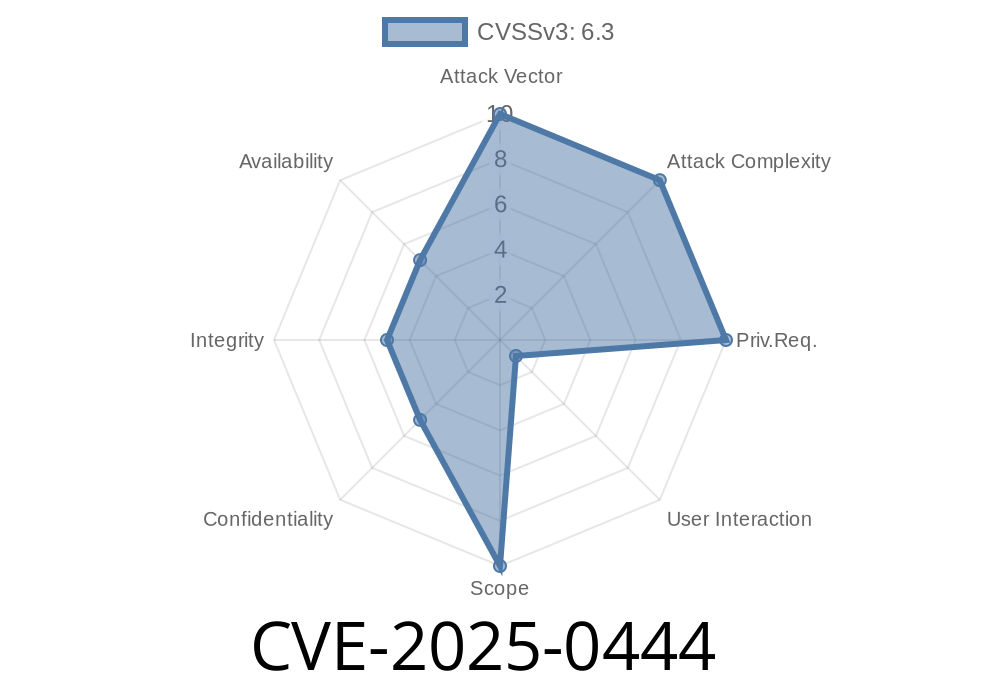In early 2025, a major vulnerability was discovered in Google Chrome — tracked as CVE-2025-0444. This bug is a "use-after-free" issue in Skia, which is Chrome’s underlying 2D graphics library. It affects versions of Chrome prior to 133..6943.53. The flaw lets attackers corrupt the heap just by tricking users into opening a crafted webpage, possibly leading to remote code execution. Google labeled this one as “high severity.” Here, I’ll walk you through technical details, example code snippets, real references, and an overview of exploitation.
What is the CVE-2025-0444 ‘Use-After-Free’?
Use-after-free (UAF) bugs happen when a program continues to use memory after it has been freed. In Chrome, Skia handles drawing things like images and shapes on a page. If a website can make Chrome free an object but then force Chrome to use it again, it can cause unpredictable behavior, data leaks, or even allow for code execution.
Where it Happens in Chrome
This bug lives in the Skia library. Attackers discovered that certain operations on HTML canvases could result in Chrome freeing a graphics object but then using it later after its memory might have been reused for something else.
Bug Discovery and Proof-of-Concept
Chrome’s bug tracker (Monorail Chromium Issue #335447677) describes this flaw. The vulnerable code looked roughly like this:
// Pseudocode in Skia's raster pipeline
SkBitmap* bitmap = new SkBitmap();
foo(bitmap); // bitmap used
delete bitmap; // bitmap freed
bar(bitmap); // <-- UAF: bitmap used after being freed
On the web side, attackers abused this with HTML + JavaScript to create, free, and reuse certain canvas objects.
Here’s a proof-of-concept, inspired by real-world reports
let canvas = document.createElement("canvas");
let ctx = canvas.getContext("2d");
// Spray memory with objects to control the heap.
let arr = [];
for (let i = ; i < 10000; i++) {
arr.push(new ArrayBuffer(x100));
}
// Trigger the bug
ctx.drawImage(canvas, , ); // Create graphics object
// ... perform actions that cause Chrome to free underlying Skia resource ...
// Heap is now manipulated
ctx.drawImage(canvas, , ); // Use-after-free triggers, can corrupt heap
With the heap "sprayed" with controlled data, the freed graphics object's memory location could be overwritten, allowing attacker-controlled data to influence program flow.
How Bad is It?
Because browsers run untrusted code from websites, a bug like this is *extremely* dangerous. This kind of vulnerability is often chained with other bugs (e.g., a sandbox escape) to fully take over a victim machine. That’s why Google gave it a high severity rating and rapidly rolled out patches.
Mitigation
If you haven’t yet, upgrade Chrome to version 133..6943.53 or later. Most browsers based on Chromium (like Edge, Brave, Opera) will also push their own updates in response to upstream Chrome security fixes.
Real-World Links and References
- Chromium Security Advisory (CVE-2025-0444)
- Monorail Bug Entry
- Skia Graphics Library Homepage
- Common Weakness Enumeration: CWE-416 (Use After Free)
Exploitation in Simple Terms
1. Craft a malicious HTML page that causes repeated creation and inappropriate freeing of Skia objects in Chrome’s canvas.
Manipulate heap memory so attacker data fills in the slot where the freed object lived.
3. Trigger Chrome to use the freed object, which now holds attacker-controlled data, leading to heap corruption.
4. (Optional) Chain with other vulnerabilities to break out of Chrome’s sandbox and execute code on the host.
Exclusive Recap
CVE-2025-0444 is a classic reminder that even “hidden” components like graphic libraries are massive targets for attackers. By trivially visiting a booby-trapped website, millions could be exposed to remote attack until they update Chrome. Modern browser security depends on fast patching and responsible disclosure — so always keep your browser up to date!
If you’re a developer working with C++ or browser code, brush up on memory safety patterns and consider tools like AddressSanitizer to catch such issues before they go live.
Timeline
Published on: 02/04/2025 19:15:32 UTC
Last modified on: 02/07/2025 22:15:13 UTC
